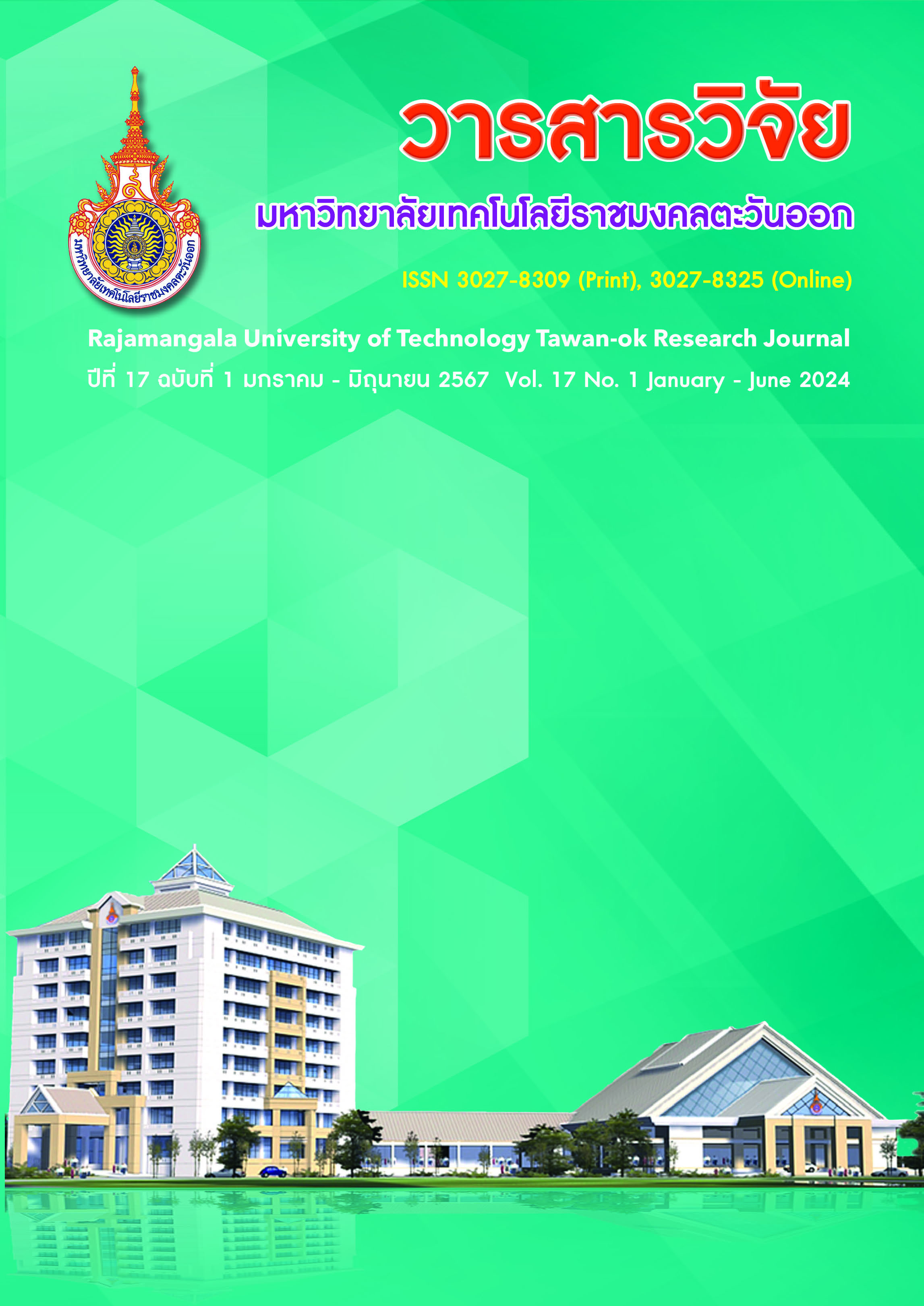การจำแนกเชื้อราต้านเชื้อ Vibrio (Penicillium decumbens) เพื่อยับยั้งการเจริญของ Vibrio parahaemolyticus เชื้อแบคทีเรียสาเหตุโรคของกุ้ง
Main Article Content
บทคัดย่อ
ราสายพันธุ์ A5-1 ที่คัดแยกจากนาเกลือ จังหวัดจันทบุรี สามารถยับยั้ง Vibrio parahaemolyticus (Vp) แบคทีเรียสาเหตุโรคกุ้งได้ด้วยเทคนิค dual culture การจำแนกทางสัณฐานวิทยาร่วมกับอนูพันธุศาสตร์ของลำดับเบสที่ตำแหน่ง SSU rRNA และ 18S rRNA พบว่าสายพันธุ์ A5-1 จำแนกได้เป็น Penicillium decumbens ราสามารถผลิตเอนไซม์เจลาทิเนส ไลเปส เซลลูเลส โปรติเอส และเจริญได้ในอาหารที่มีความเข้มข้นของเกลือระดับต่างๆ (0-60 psu) จัดเป็นราทนเค็ม ใช้การออกแบบการทดลองแบบแฟคทอเรียลรวม 36 ชุดการทดลองเพื่อศึกษาปัจจัยที่มีผลต่อการสร้างสารยับยั้งวิบริโอพบว่า ทุกชุดการทดลองให้ค่าโซนใสต่อการยับยั้ง Vp ดังนั้น pH ความเข้มข้นแอมโมเนียมและความเค็มที่เพิ่มขี้นมีผลต่อการสร้างสารของรา โดยชุดทดลอง T36 (1.0:9:30) ให้ค่าของโซนใสยับยั้ง Vp มากที่สุดเท่ากับ 2.56±0.06 ซม. การเจริญร่วมกันในอาหารเหลวพบว่าที่ความเค็ม 10 และ 20 psu ความเข้มข้นของสปอร์ราที่ 7.08x105 สปอร์/มล. และ 1.36x106 สปอร์/มล. สามารถลดจำนวน Vp จากเซลล์เริ่มต้นที่ 105 CFU/mL ให้น้อยกว่าหรือเท่ากับ 100 CFU/mL ได้ตั้งแต่ชั่วโมงที่ 24 และที่ความเค็ม 30 psu ความเข้มข้นของสปอร์ราที่ 2.47x106 สปอร์/มล. และ 2.94x106 สปอร์/มล. สามารถลดจำนวน Vp จากเซลล์เริ่มต้นที่ 107 CFU/mL ให้น้อยกว่า 100 CFU/mL ได้ที่ชั่วโมงที่ 96 ดังนั้นสามารถประยุกต์ใช้ P. decumbens A5-1 ในการควบคุมจำนวนของ Vp ในการเพาะเลี้ยงกุ้งทะเล
Article Details

This work is licensed under a Creative Commons Attribution-NonCommercial-NoDerivatives 4.0 International License.
References
Abdel-Aziz, F.A. (2008). Diversity of aquatic fungi on Phragmites australis at lake Manzala, Egypt. Sydowia,60(1): 1-14.
Adiwidjaya, D., Raharjo, S.P., Sutikno, E., & Subiyanto, S. (2003). Technical guidelines for environmentally friendly closed system vannamei shrimp farming. Ministry of Marine Affairs and Fisheries, Directorate General of Aquaculture. (Jepara: Center for Brackish Water Cultivation Development) p. 29 [in Indonesia]
Atsumi, T., McCartert, L., & Imae, Y. (1992). Polar and lateral flagellar motors of marine Vibrio are driven by different ion-motive forces. Nature, 355: 182-184.
Barnett, H.L., & Hunter, B.B. (2006). Illustrate genera of imperfect fungi. New York: Macmillan Publishing Company.
Butinar, L., Frisvad, J.C., & Gunde-Cimerman, N. (2011). Hypersaline waters: A potential source of foodborne toxigenic aspergilli and penicillia. FEMS Microbiology Ecology, 77(1): 186-199.
Chucherd, N. (2013). The case study of EMS in Thailand. Asian Aquaculture Network, The Practical Megazine, 4(13): 14-19.
Dinesh, R., Anandaraj, M., Kumar, A., Bini, Y.K., Subila, K.P., & Aravind, R. (2015). Isolation, characterization, and evaluation of multi-trait plant growth promoting rhizobacteria for their growth promoting and disease suppressing effects on ginger. Microbiological Research, 173: 34-43.
Durand, D.J., Gordon Green, B., O’ Connell, J.F., & Grant, S.K. (1999). Peptide aldehyde inhibitors of bacterial peptide deformylases. Archives of Biochemistry and Biophysics, 367(2): 297–302.
Fuentes, M.E., & Quiñones, R.A. (2016). Carbon utilization profile of the filamentous fungal species Fusarium fujikuroi, Penicillium decumbens, and Sarocladium strictum isolated from marine coastal environments. Mycologia, 108(6): 1069-1081.
Fujii, Y., Asahara, M., Ichinoe, M., & Nakajima, H. (2002). Fungal melanin inhibitor and related compounds from Penicillium decumbens. Phytochemistry, 60(7): 703-708.
Gomes, J.E.G., Nascimento, T.C.E.S, de Souza-Motta, C.M., Montalvo, G.S.A., Boscolo, M., Gomes, E., Moreira, K.A., Pintado, M.M., & Silva, R.D. (2022). Screening and application of fungal proteases for goat casein hydrolysis towards the development of bioactive hydrolysates. Journal of Food Measurement and Characterization, 16(6): 4650-4664.
Griffith, R. W. (1994). The life of the first vertebrates. Bioscience, 44(6): 408-417.
Guevara-Suarez, M., Sutton, D., Cano-Lira, J., García, D., Martin-Vicente, A., Wiederhold, N., Guarro, J., & Gené., J. (2016). Identification and antifungal susceptibility of Penicillium-like fungi from clinical samples in the United States. Journal of Clinical Microbiology, 54(8): 2155–2161.
Gunasekaran, P. (1995). Laboratory manual in Microbiology. New Delhi: New Age International Publishers.
Gunde-Cimerman, N., Zalarb, P., de Hoog, S., & Plemenitas, A. (2000). Hypersaline waters in salterns-natural ecological niches for halophilic black yeasts. FEMS Microbiology Ecology, 32(3): 235–240.
Guo, J., Yang, J., Wang, P., Guo, B., Li, H., Zhang, D., An, F., & Gao, S. (2023). Anti-vibriosis bioactive molecules from Arctic Penicillium sp. Z2230. Bioresources and Bioprocessing, 10(1): 11
Haliman, R.W., & Adijaya, D. S. (2005). Vanamei shrimp and disease-resistant white shrimp market prospects. (Jakarta: Penebar Swadaya) p.75 [in Indonesian]
Hu, S., Li, Y., Wang, B., Yin, L., & Jia, X. (2022). Effects of NaCl concentration on the behavior of Vibrio brasiliensis and transcriptome analysis. Foods, 11(1): 840-856.
Kushner, D. J. (1993). Growth and nutrition of halophilic bacteria. In Vreeland, R. H. & Hochstein, L. (Eds.), The Biology of halophilic bacteria (87-103). Florida: CRC Press.
Lin, S., Shi, T., Chen, K.Y., Zhang, Z.X., Shan, L., Shen, Y.H., & Zhang, W.D. (2011). Cyclopenicillone, a unique cyclopentenone from the cultures of Penicillium decumbens. Chemical Communications, 37: 10413-10415.
Mandeel, Q.A. (2006). Biodiversity of the genus Fusarium in saline soil habitats. Journal of Basic Microbiology, 46(6): 480-494.
Mani, A., Chauhan, R., & Abraham, J. (2016). Antimicrobial and antioxidant potential of Penicillium decumbensstrain AJA1 against various pathogens. Research Journal of Pharmacy and Technology, 9(7): 801.
Ong, C.J.N., Clemente, R.F., Alaijos, O.R., Pascual, L.J., Aguilar, R.N., & Desacula, R. (2023). In-silico molecular
phylogeny of Philippine Myxomycetes using 18S rRNA and small subunit rRNA (SSU) gene Sequences. Journal of Tropical Life Science, 13(3): 421–430.
Phongpaichit, S., Nikom, J., Rungjindamai, N., Sakayaroj, J., Hutadilok-Towatana, N., Rukachaisirikul, V., & Kirtikara, K. (2007). Biological activities of extracts from endophytic fungi isolated from garcinia plants. FEMS Immunology & Medical Microbiology, 51(3): 517-525.
Plemenita, A., Vaupotic, T., Lenassi, M., Kogej, T., & Gunde-Cimerman, N. (2008). Adaptation of extremely halotolerant black yeast Hortaea werneckii to increased osmolarity: A molecular perspective at a glance, Studies in Mycology, 61: 67-75.
Sepcic, K., Zalar, P., & Gunde-Cimerman, N. (2011). Low water activity induces the production of bioactive metabolites in halophilic and halotolerant fungi. Mar Drugs, 9(1): 43-58.
Suantika, G., Lumbantoruan, G., Muhammad, H., Azizah, F.F.N., & Aditiawati, P. (2015). Performance of zero water discharge (ZWD) system with nitrifying bacteria and microalgae Chaetoceros components in super intensive white shrimp (Litopenaeus vannamei) culture. Journal Aquaculture Research & Development, 6(9): 359-364.
Xu, L., Meng, W., Cao, C., Wang, J., Shan, W., & Wang, Q. (2015). Antibacterial and antifungal compounds from marine fungi. Mar Drugs, 13(6): 3479-3513.
Yeung, P.S., & Boor, K.J. (2004). Epidemiology, pathogenesis, and prevention of foodborne Vibrio parahaemolyticus infections. Foodborne Pathogens and Disease, 1(2): 74-88.
Yingkajorn, M., Mitraparp-Arthorn, P., Nuanualsuwan, S., Poomwised, R., Kongchuay, N., Khamhaeng, N., & Vuddhakul, V. (2014). Prevalence and quantification of pathogenic Vibrio parahaemolyticus during shrimp culture in Thailand. Diseases of Aquatic Organisms, 112(2): 103-111.
Zhou, Q., Li., K., Xie, J., & Liu, B. (2009). Role and functions of beneficial microorganisms in sustainable aquaculture. Bioresource Technology, 100(16): 3780–3786.

